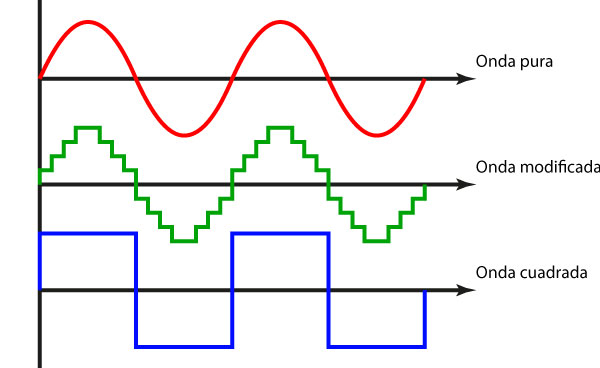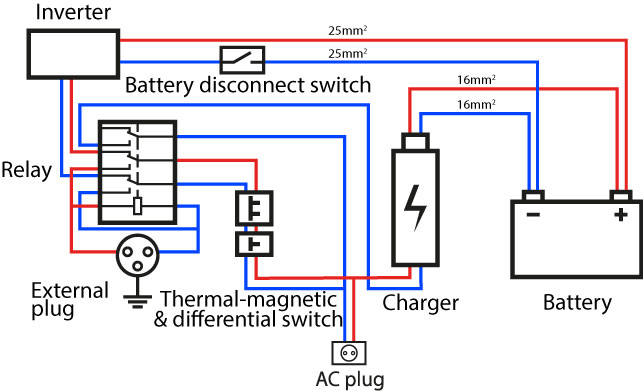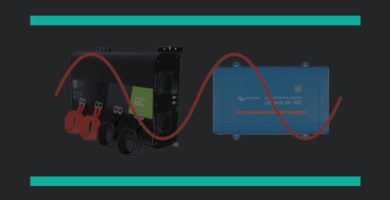don’t have 220V in your camper van? If you think it can be useful, what are you waiting for? Don’t think twice and buy an inverter! We can’t imagine living in the camper without it. Being able to use “normal” electrical appliances at 220V in the van has been a before and after for us. If you still don’t know what types of inverters there are or which one best suits your needs and budget, read on and we’ll help you find out.
What types of inverters are there and which one is best for my camper?
If you do not know very well what features each one has or how they differ, read our posts and get out of doubts! In addition, we tell you the best and the worst of the most popular inverter models.
What is an inverter for and why do we need one in our camper van?
A power inverter is a device that transforms a direct current (DC) at a certain voltage, which can be 12, 24, etc., into an alternating current (AC), in our case at 220V, suitable for the use of conventional electrical and electronic devices. Therefore, if you want to be able to use 220V devices in the van, you will have to get a power inverter.
Alternating current is a type of electric current whose voltage varies at constant intervals in a cyclical manner, half the time it will be positive (the energy circulates in one direction) and the other half negative (it circulates in the opposite direction) forming, normally, a sine wave.
What should you look for when buying an inverter?
Choosing an inverter for a van is not a simple matter, as each user will have specific needs to meet. However, there are a number of basic features you should look for when buying the inverter for your camper van:
- pure wave or modified wave: Many people think that the most important thing when choosing the inverter is the power it delivers, in our opinion, first of all you should assess whether you want/can invest more money in a pure wave inverter or if the appliances you plan to use would work well with a modified wave inverter. If you are not very clear about the differences between one and the other you might want to click on the links above and read a little more about each of them. If you want a quick answer, we will tell you that electronic devices work much better with pure sine wave inverters, in fact some will not work with a modified sine wave inverter.

- what voltage is your battery: When choosing an inverter you will need to look at what its input voltage is and that this voltage matches the voltage of the battery you will be connecting it to.
- how much power do you need it to deliver? At this point you will need to assess what appliances you plan to connect to the inverter. Keep in mind that if an inverter is marked as delivering 800W of nominal power, in normal conditions of use it will actually deliver around 650W, so take your time and think about what minimum power you need.
the power consumed by your devices should not exceed 85% of the inverter’s rated power!
- what is the capacity of your battery: When choosing the power of your inverter you also have to take into account the capacity of your battery. If you think about it, it makes no sense to connect a 12V 1200W inverter to an 80Ah battery. To give you an idea of the relationship between inverter power and battery capacity, we leave you a table with the recommendations given in the Victron Energy Phoenix inverter manual (see on Amazon):
| Inverter | 12V/250W | 24V/250W | 48V/250W |
|---|---|---|---|
| Battery | 30Ah | 20Ah | 10Ah |
| Inverter | 12V/375W | 24V/375W | 48V/375W |
|---|---|---|---|
| Battery | 40Ah | 30Ah | 15Ah |
| Inverter | 12V/500W | 24V/500W | 48V/500W |
|---|---|---|---|
| Battery | 60Ah | 40Ah | 20Ah |
| Inverter | 12V/800W | 24V/800W | 48V/800W |
|---|---|---|---|
| Battery | 100Ah | 50Ah | 30Ah |
| Inverter | 12V/1200W | 24V/1200W | 48V/1200W |
|---|---|---|---|
| Battery | 150Ah | 60Ah | 30Ah |
- Are you going to take it with you: There is a wide variety of inverter models on the market. There are those to screw directly to the floor or wall, with handles that make them more manageable, such as this pure wave inverter BESTEK 12-220V 1000W (see on Amazon), smaller and portable, etc.. The right choice will depend on your needs.
- what outputs do you need it to have: When looking at inverter catalogs you will see that there are many different models. Normally they have one or two 220V Schuko outlets (European plug), but there are also models that include, for example, USB outlets
- how much are you willing to spend? as with most products on the market, when comparing different inverter models you can see that there is a wide range of prices that, many times, are in line with their features. Does this mean that you have to buy the most expensive model? Absolutely not. Evaluate your needs, what each inverter model offers you and how often you will use it. It makes no sense to spend a lot of money on a 2000W pure wave inverter if you will hardly get any use out of it.
Where should you install your inverter?
Before you jump into buying an inverter, you should stop for a few minutes, analyze the layout of your van, think about where you are going to place the electrical installation in your camper van and measure what space you can reserve for the inverter. So, what do you need to consider when positioning your inverter?
- The mounting position: Each inverter model has specific mounting positions tested and allowed by the manufacturer. Some models may be designed to be mounted on the wall, on the ground or in both positions, so we recommend reading both the product specifications and the manual and following the manufacturer’s mounting instructions.
- Look for a place close to the battery: If you have already done some research on the subject, or already had previous knowledge, you will know that the cables that go from the battery to the inverter have to have a considerable section, since the intensity of the current that will circulate through them will be high. So, in general, the shorter the distance from the inverter to the battery, always respecting the spaces for ventilation, the shorter the cables will need to be and the less risk of overheating there will be.
- Ventilation space: As already mentioned, it is very important that you respect the manufacturer’s installation instructions. Among other things, they usually specify that the air flow around the inverter must not be obstructed and a minimum of 10 cm of free space must be left around the inverter.
Remember that electrical appliances need specific installation conditions, specific positions and space for ventilation.
Is it easy to install an inverter in a camper?
The camper world is in “fashion”. There are undoubtedly more and more users of campers and motorhomes and the number of people who are starting to camperize their own van is also increasing. But it is also true that, when it comes to the electrical installation, many people are a bit put off by the idea of doing it themselves. If this is your case, take a look at our post, read how to do the electrical installation in a camper van and discover that it is not as complicated as it may seem.
In addition, an electrical installation can be as simple as having only the auxiliary battery and connect the inverter: Positive cable from the inverter to the positive pole of the battery, then the same with the negative and plug the consumption directly to the inverter outputs. Or it can be “complicated” as you want or need to add more elements.
To make a fixed 220V installation in your van, and to be able to homologate it, you will need an electrical bulletin issued by an official installer.
Below we show you an image of our 220V installation diagram, for information purposes, in case you need some inspiration to design your own.

You can also add a fuse in the cable that goes from the positive of the battery to the inverter. Its dimension will depend on the cable section. In addition, also take into account if the fuse of your inverter is replaceable or not.
Remember that each electrical installation is different. This is the schematic of our 220V electrical installation. With this we do not mean that this design is the best or the one that adapts to all use cases, it is simply ours.
Frequently asked questions from users
Can a battery charger be plugged into the inverter output and charge the battery at the same time?
If your intention is to charge the same battery that feeds the inverter, the answer is no. Firstly, the efficiency of no inverter reaches 100%, with current technology, so in the process of transforming the energy from 12V to 220V is already consuming an amount. Secondly, the charger transforms that 220V energy back to 12V, generating another consumption, so the energy that will finally return to the battery will be less than the one that will have left, therefore the battery will continue to be discharged.
If, however, your intention is to charge another stand-alone external battery, the answer is yes. The charger will operate normally. But as in the previous situation, both the inverter and the charger will generate a consumption, so the charge of the second battery will be less than the discharge of the first one.


